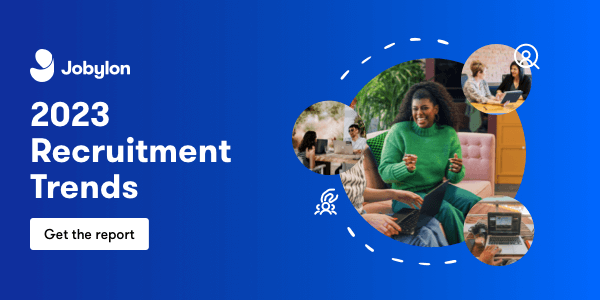The effect of the pandemic on recruitment has been profound. Recruiters have recently faced several staffing challenges caused by COVID and the Great Resignation, including a volatile employment market, urgent hiring needs, and candidates disillusioned with employers. While the pandemic has started receding, these challenges persist in 2022. Specifically, a recent survey reported that many businesses are struggling to find qualified candidates, with 50% of business owners saying they had job vacancies they could not fill.
By 2030, Korn Kerry predicted that more than 85 million jobs could go unfilled due to a global talent shortage, costing businesses more than $8 trillion in lost economic opportunity. With increased competition for talent, having an understanding of the current talent acquisition landscape may no longer be enough. Recruitment leaders need to stay on top of upcoming talent acquisition trends, too. In this article, we present you with our seven predictions for recruitment in 2030 to help you hire the best talent today and in the coming years.
1. More sophisticated AI Recruitment tools
Most companies, from small businesses to Fortune 500 corporations, use recruitment technology to identify, attract, and hire the best talent. However, while talent acquisition tools have already enabled businesses to up their hiring game, they come with certain limitations. For example, current artificial intelligence (AI) may be great to automate transactional parts of the recruitment process, however, it may not be as successful in processing strategic work, such as decision making. In fact, some recruitment apps that included functionality aiming to facilitate decision making have been criticized for making recommendations that aren’t in line with diversity & inclusion requirements.
We believe that by 2030 AI will be refined in such a way that recruitment software will be invaluable in every part of the recruitment process, contributing to transactional, operational, and strategic tasks. Specifically, we expect that talent acquisition applications will help recruiters to identify talent based on their needs, attract this talent through a personalized candidate experience, assess applicants in a relevant way, and match them to suitable roles. Essentially, these tools will be the right hand of a recruiter, enabling them to hire top talent, fast.
This sophisticated technology will provide employers with a wide range of benefits, including cost and time efficiencies, increased quality of hires, and better employer branding prospects. However, we don’t see recruitment technology replacing recruiters anytime soon. In fact, AI deployment in recruitment is intended to enhance their roles, helping them in being successful and freeing up their time to work on more strategic tasks.
While there are several types of recruitment tools using AI, they all focus on talent attraction, candidate managing, or applicant assessment. For example, Recruitment chatbots provide relevant information to potential applicants, attracting relevant talent. Applicant Tracking Systems (ATS) manage candidates by tracking their applications, facilitating communications, and supporting the assessment process. Lastly, some assessment tools use AI to evaluate candidates and make hiring recommendations through tests or other relevant activities. We envisage that by 2030 there will be more tools in each of the above categories, offering employers a wide range of solutions for their hiring needs.
2. More creative approaches to employer branding
In today's competitive job market, a strong employer brand is critical to attracting highly-qualified talents. According to a Glassdoor survey, more than 80% of employees and job seekers said a company's reputation impacts their decision on whether to apply for a job or not. Furthermore, most of them wouldn’t work for a company with a bad image, even for competitive pay. These show the importance of a well-defined employer branding to win the best candidates.
During the last decade, we have seen employers across industries increasing their focus on building, nurturing, and maintaining a great reputation to make themselves stand out in the employment market. Due to high competition, we expect employers to get more creative in the future, using new approaches to enhance their employer brands further by 2030. We think that these new employer branding initiatives will be applied throughout the talent acquisition process.
Black and white text job ads will be a thing of the past. Most companies will shift to modern job ads that create recognition in their target audience and attract high-quality applicants. The use of non-traditional media for employer branding will become prevalent. Examples may include social media such as Instagram, TikTok, and YouTube, or other platforms like Reddit and Quora. In summary, savvy employers will monitor their target audience and broadcast their employer brand where talent lives. This iterative process will allow them to inform potential candidates about their business, roles, and culture.
3. An increasing focus on social recruitment
According to a recent report, more than half of the total global population are now social media users. This mind-boggling number is continuously growing at a rate of 7.5 per cent per year. With this in mind, social networks undoubtedly house the largest repository of talent globally. So, it is no surprise how it has evolved from a platform merely for digital socialization to a powerful hiring channel.
This is evident based on the volume of companies already using social recruitment as a key hiring channel. Specifically, an SHRM survey revealed that 84% of organizations use one or more social media as part of their talent acquisition to identify, assess, and hire candidates. Furthermore, 52% of candidates said they use social media to search and learn more about an employer before applying for a job.
Social recruiting has been on the rise for many years. With the continued growth in social media users, we expect this trend to continue growing rapidly by 2030. So, if you are not yet using social media for recruitment, then it may be time for you to change your recruitment strategy and join the ongoing trend.
4. More emphasis on soft skills
Soft skills have become increasingly important in the workplace. This is because they are highly transferable and can be applied in various roles and industries. The increasing demand for soft skills is evident in a study conducted by Deloitte, where it was revealed that soft-skill-intensive jobs would increase 2.5X faster than other jobs. Furthermore, the same study predicted that soft-skill-focused jobs will make up more than 60% of all jobs by 2030.
In fact, soft skills are already a key requirement for many hiring managers. While most candidates receive additional training on technical skills once hired, they don’t typically receive the same support for soft skills development, as these are harder to teach. As a result, many companies are experiencing a widespread soft skills deficit. In fact, the same study from Deloitte reported that 75% of organizations already have a shortage of soft skills in their workforce. Due to this gap, many companies are expected to continue increasing their focus on hiring for soft skills by 2030.
5. Candidate experience will remain key
Candidate experience refers to the overall perception of an applicant about a company’s hiring process. This is especially crucial during the candidate’s first stages of interaction with the organization, as it can impact their decision to apply for your jobs or accept your offer should they be selected. Also, if you establish a positive experience, a candidate is most likely to advocate for your brand. In fact, an IBM research revealed that candidates with a positive experience are more than twice as likely to recommend the company to others regardless of their application outcome.
Conversely, a bad candidate experience may tarnish a company’s reputation, impacting even revenues and profits. This proved to be true by the study on bad candidate experience conducted by Virgin Media. Based on data, they found that the company lost about $5 million in revenue within the year due to this issue. At this stage, it is apparent that ensuring a positive candidate experience needs to be a company-wide priority. With an increasingly competitive talent market, we expect this to remain unchanged by 2030.
6. More emphasis on relevant data
Many businesses have already turned to talent management software to manage their overall talent cycle, making it easier for them to gather and analyze data. As a result, data-driven recruitment has now become a common concept in talent acquisition. This involves the utilization of technologies, techniques, and data to make hiring decisions and plans and streamline the hiring process. The proper utilization of HR analytics has been proven to help businesses improve the quality of hires, stay diverse, and increase productivity and efficiency, among others. However, recruitment analytics are not always sophisticated yet, making it challenging to get relevant and accurate information.
According to Fortune Business Insights, the global talent management software market size is projected to grow from $7.09 billion in 2021 to $17.66 billion by 2029. With a CAGR growth of 12.1%, more and more companies are expected to take advantage of the latest advancements in talent management software to optimize their analytics further and enable data-driven decision making. By 2030, we expect that recruitment data tools will be far more sophisticated, allowing employers to have the information they need at their fingertips.
7. An increase in proactive recruitment methods
The global pandemic has reshaped everything about recruitment, from attracting to selecting talent. It forced Talent Acquisition teams to adapt and revamp their strategies to satisfy the requirements of our new BAU. If there is one thing that we all learned through this process, it is the importance of preparation.
With widespread upcoming talent shortages reported and talent getting pickier, recruitment may now be more challenging than ever. In turn, traditional talent acquisition methods will not work like they used to. Employers need to stay ahead and be proactive if they are looking to hire the best talent.
By changing their recruitment approach, companies are now searching more broadly outside their traditional recruitment channels to discover hidden talent gems. Also, when they find relevant talent, they reach out proactively rather than sitting back and waiting for applications to come in. This will remain the case in 2030 with proactive recruiters winning the war for talent.
The above trends show that emerging technologies and uncertainties in the talent market will significantly influence the way organizations hire by 2030. So, paying attention to these trends can be the key to hiring great talent and standing out in a highly competitive talent marketplace. If you need help with improving your recruitment process and attracting high-quality talents, don’t hesitate to get in touch with us.






